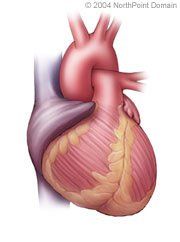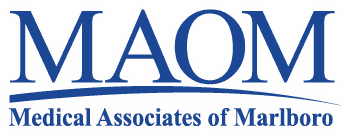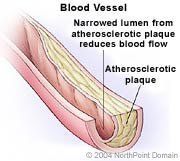High Cholesterol
Basic Facts
- High cholesterol, also called hypercholesterolemia, means that levels of cholesterol in the blood are raised, which can contribute to plaque build-up on artery walls.
- High cholesterol is a lipid disorder. Physicians use the term lipid disorder to describe several conditions in which high concentrations of lipids (fats) exist in the bloodstream and in part by inherited disorders.
- Elevated levels of cholesterol in the blood can be caused in part by a diet high in fat and cholesterol-laden foods.
- Although there is no one standard for high cholesterol, physicians have established ranges of cholesterol levels that are useful in assessing a person's risk of developing coronary heart disease.

Cholesterol helps form cell membranes and vitamin D, is an essential building block of hormones, and helps produce bile, which helps digestion and nutrient absorption. The liver produces enough cholesterol for the human body. However, foods high in saturated fat, such as meat, butter, cheese, milk, and eggs, can increase the amount of cholesterol in the blood.
Cholesterol circulates in the bloodstream as part of complex substances called lipoproteins or lipid proteins, including:
- High-density lipoprotein (HDL), called "good" cholesterol, which transports cholesterol from blood in the arteries to the liver where it is broken down and removed from the body; and
- Low-density lipoprotein (LDL), called "bad" cholesterol, which deposits cholesterol in the body's cells and tissues.
High levels of all the cholesterol carried by lipoproteins, called total cholesterol, increase the risk for atherosclerosis, or hardening of the arteries. Physicians consider a total blood cholesterol level of more than 200 milligrams per deciliters (mg/dL) or a LDL level of 160 mg/dL or more to be high cholesterol. For people with established cardiovascular disease or related diseases, such as diabetes mellitus, a target LDL level of less than 100 mg/dL is sought.
Atherosclerosis thickens artery walls and narrows the space through which blood must flow, which can contribute to the following cardiovascular conditions:
- Angina;
- Heart attack;
- Stroke; and
- Occlusive arterial disease in other parts of the body, such as the arms and legs.
WHAT ARE THE SYMPTOMS?
High cholesterol itself does not cause symptoms. However, some people with high cholesterol may experience symptoms from related conditions. These symptoms may include:
- Chest pain;
- Muscle pain; and
- Muscle weakness from ischemia (blood flow that is insufficient to provide enough oxygen).
CAUSES AND RISK FACTORS
In addition eating a diet high in saturated fat, other risk factors that contribute to high cholesterol include:
- Being obese;
- Age (men older than 45 and women older than 55 are at increased risk for high cholesterol);
- Family history of atherosclerosis;
- Having high blood pressure;
- Having diabetes; and
- Being physically inactive.
People who inherit high cholesterol, a condition called inherited hyperlipoproteinemia, often have cholesterol levels that are 2 to 3 times higher than normal.
DIAGNOSIS
Physicians can diagnose high cholesterol after performing a careful medical history and physical that includes measuring blood pressure and testing blood cholesterol levels (which should be a part of each regular physical). If total cholesterol levels are elevated, a physician may also obtain a breakdown of blood levels of specific lipids, including LDL, HDL, and triglycerides, another form of lipid found in the blood.
Annual cholesterol tests may be indicated in some instances, such as when other risk factors for coronary heart disease (CHD) besides high cholesterol are present.
TREATMENT APPROACH
Physicians treat high cholesterol by attempting to reduce the LDL cholesterol level through either lifestyle changes and, when necessary, medication. Although one standard does not exist for a target LDL level, physicians have established ranges of cholesterol levels that are useful in assessing a person's need for treatment. Those ranges help physicians assess when a person's cholesterol level is elevated enough to warrant lifestyle modification, medical treatment, or both.
Lifestyle. In some cases, changing one's lifestyle may lower LDL levels enough to reach the target. Such lifestyle changes include:
- Reducing saturated fat to less than 7 percent of total calories and reducing total fat intake to 25 to 35 percent of daily calories;
- Losing weight (especially weight around the middle of the body, which is a greater risk to the heart than weight clustered around the hips, thighs, and buttocks); and
- Exercising (such as brisk walking for 20 to 30 minutes, 5 times per week).
Medication. If lifestyle changes alone do not reduce blood cholesterol levels or if cholesterol levels are thought to be genetically determined, medication may be required. Patients should continue lifestyle changes while taking medications.
The drugs typically used to lower high lipid levels fall into four categories:
- Statins which lower LDL and triglycerides by blocking the liver from producing cholesterol. Because statins tend to thin the blood, physicians must closely monitor patients who also take warfarin or other anticlotting agents;
- Bile acid sequestrants which block reabsorption of fat so that LDL levels fall;
- Fibrates which lower cholesterol and triglycerides in the blood; and
- Niacin (Vitamin B3) which lowers blood lipids at dosages of 3 to 8 grams per day.
A new class of agents called cholesterol absorption inhibitors lowers LDL cholesterol by 15 to 20 percent and slightly improves HDL cholesterol and triglycerides. The only such medication approved by the United States Food and Drug Administration is ezetimibe (Zetia).
Cholesterol-lowering drugs may cause side effects, such as liver problems or muscle pain. These effects are rare and are almost always reversible when the drugs are stopped or the dosages are reduced.
Copyright © 2017 NorthPoint Domain, Inc. All rights reserved.
This material cannot be reproduced in digital or printed form without the express consent of NorthPoint Domain, Inc. Unauthorized copying or distribution of NorthPoint Domain's Content is an infringement of the copyright holder's rights.

